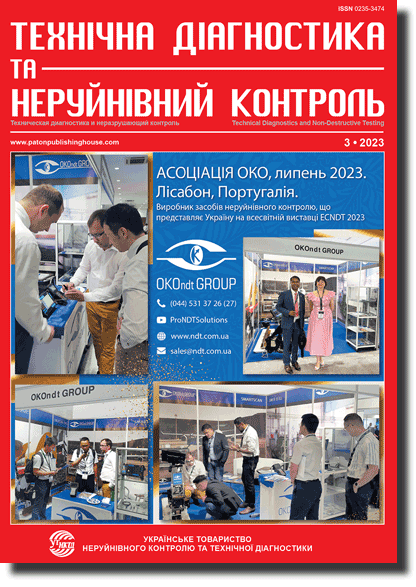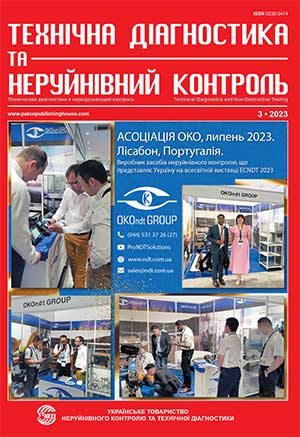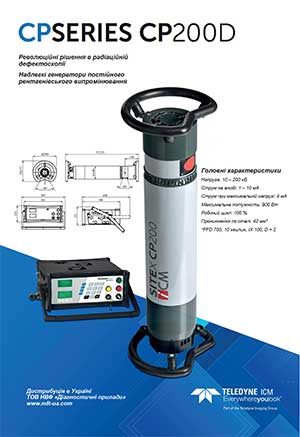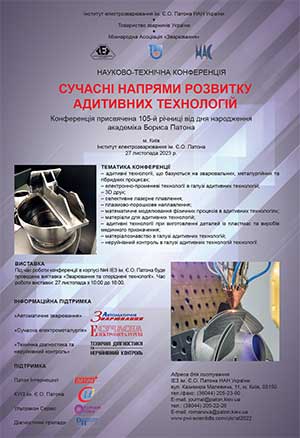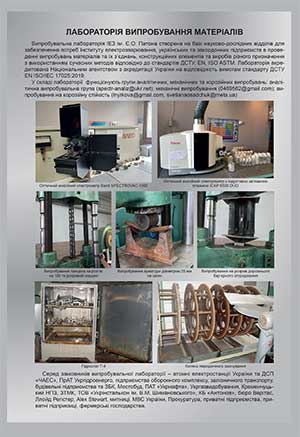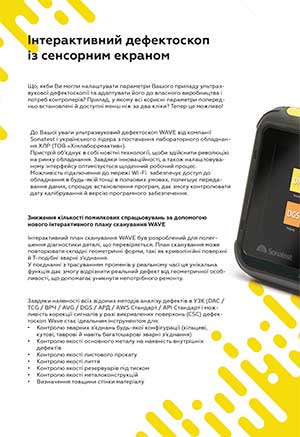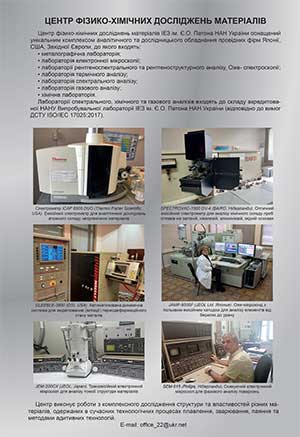| 2023 №03 (05) |
DOI of Article 10.37434/tdnk2023.03.01 |
2023 №03 (02) |
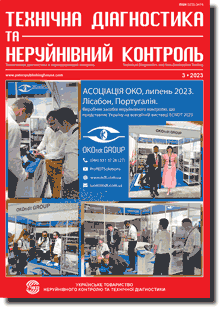
"Tekhnichna Diahnostyka ta Neruinivnyi Kontrol" (Technical Diagnostics and Non-Destructive Testing) #3, 2023, pp. 3-9
Distribution of effective coercive force of composite samples at its measurment by attachable magnetic transducers
R.M. Solomakha2, V.G. Rybachuk1, V.M. Uchanin1
1G.V. Karpenko Physico-Mechanical Institute of NASU. 5 Naukova str., 79060, Lviv, Ukraine. E-mail: vuchanin@gmail.com2SPF «Spetsialny naukovy rozrobky». 10 Svitla str., 61121, Kharkiv. E-mail: rsolomak@gmail.com
The paper presents the results of studying the distribution of effective coercive force (CF) in composite ferromagnetic standard samples assembled from two homogeneous samples with different CF values, abutted to each other. Two types of attachable U-shaped magnetic transducers (MT), which were connected to MA-5 type magnetic analyzer, were used for measurement of effective CF in a closed magnetic circuit. Measurements in an open magnetic circuit were performed using MT of attachable solenoid type, operating by the pole point method (PPM). This MT was connected to a coercimeter-structurescope of IKS-104 type. It is shown that for all MT types the effective CF of composite samples (CS) depends on their position relative to the butt. With MT movement relative to the butt from homogeneous sample with smaller CF to homogeneous sample with larger CF the effective CF increases in the range between CF values of these samples. Quantitatively, the nature of distribution of CS effective CF depends on MT type, its dimensions and type of their orientation relative to the butt for MT of non axisymmetric design. With parallel orientation of the poles of U-shaped MT relative to the butt, the nature of the changes in effective CF is smoother. Presence of a gap between CS parts causes a decrease of effective CF and instability of its values in the butt area. For MT of the same type reduction of their size leads to decrease of effective CF range. For MT of similar size the range of the change in CS effective CF, measured in an open magnetic circuit, is noticeably larger, compared to the one measured in a closed magnetic circuit. Shown is the principal possibility of CS application for metrological support of magnetic structurescopes, as well as for modeling the two-dimensional distribution of CF of ferromagnetic structures, which are characterized by surface inhomogeneity of magnetic parameters. 18 Ref., 1 Tabl., 8 Fig.
Keywords: nondestructive testing, magnetic structuroscopy, coercive force, coercimeter, standard sample, U-shaped magnetic transducer, attachable solenoid
Received: 11.06.2023
References
1. Kwun, H, Burkhart, G.L. (1987) Effects of grain size, hardness, and stress on the magnetic hysteresis loops of ferromagnetic steels. Journal of Applied Physics, 61(4), 1576- 1579. https://doi.org/10.1063/1.3380932. Ostash, O.P., Fedirko, V.M., Uchanin, V.M. et al. (2007) Strength and service life of aircraft materials and structure elements. In: Fracture Mechanics and Strength of Materials. Vol. 9, Ed. By V.V. Panasyuk. Lviv, Spolom [in Ukrainian].
3. Bezlyudko, G.Ya. (2003) Operational control of the fatigue condition and residual life of metal structures by nondestructive (coercimetric) method. Tekh. Diagnost. i Nerazrush. Kontrol, 2, 20-26 [in Russian].
4. Bezlyudko, G., Popov, B., Solomakha, R. (2014) The metal fatigue operational monitoring using a non-destructive method of coercive force. practical and philosophical aspects. In Proc. 11th European Conf. on Nondestructive Testing (ECNDT 2014), Prague, Czech Republic, 6-10 October, 2014. Available from: https://www.ndt.net/events/ECNDT2014/ app/content/Paper/289_Solomakha.pdf >
5. Bida, G.V., Nichipuruk, A.P. (2000) Coercive force measurements in nondestructive testing. Russian Journal of Nondestructive Testing, 36(10), 707-727. https://doi.org/10.1007/BF02759255
6. Uchanin, V., Ostash, O., Nardoni, G., Solomakha, R. (2020) Coercive force measurements for structural health monitoring. In The Fundamentals of Structural Integrity and Failure, ed. Richard M. Wilcox, Nova Science Publishers, New York, Ch. 5, pp. 163-192. https://doi.org/10.1016/j.prostr.2019.07.040
7. Uchanin, V., Ostash, O. (2019) Development of electromagnetic NDT methods for structural integrity assessment. Procedia Structural Integrity, 16, 192-197. https://doi.org/10.1016/j.prostr.2019.07.040
8. Liu, J., Wilson, J., Davis, C.L., Peyton, A. (2019) Magnetic characterisation of grain size and precipitate distribution by major and minor BH loop measurements. Journal of Magnetism and Magnetic Materials, 481, 55-67. https://doi.org/10.1016/j.jmmm.2019.02.088
9. Chulkina, A.A., Ul'yanov, A.I. (2009) Effect of the magnetic properties of cementite on the coercive force of high-carbon steels after quenching and tempering. Physics of Metals and Metallography, 108(6), 548-555. https://doi.org/10.1134/S0031918X09120059
10. Ostash, O.P., Vol'demarov, O.V., Hladysh, P.V. (2014) Diagnostics of the structural-mechanical state of steels of steam pipelines by the coercimetric method and prediction of their service life. Materials Science, 49(5), 667-680. https://doi.org/10.1007/s11003-014-9661-3
11. Morishita, K., Gilanyi, A., Sukegawa, T. et al. (1998) Magnetic non-destructive evaluation of accumulated fatigue damage in ferromagnetic steels for nuclear plant component. Journal of Nuclear Materials, 258-263 (Part 2), 1946-1952. https://doi.org/10.1016/S0022-3115(98)00150-0
12. Govindaraju, M.R., Kaminski, D.A., Devine, M.K. et al. (1997) Nondestructive evaluation of creep damage in power-plant steam generators and piping by magnetic measurements. NDT&E International, 30(1), 11-17. https://doi.org/10.1016/S0963-8695(96)00042-4
. Kikuchi, H., Ara, K., Kamada, Y., Kobayashi, S. (2009) Effect of microstructure changes on Barkhausen noise properties and hysteresis loop in cold rolled low carbon steel. IEEE Transactions on Magnetics, 45(6), 2744-2747. https://doi.org/10.1109/TMAG.2009.2020545
14. Samojlovich, G.S. (1976) Nondestructive testing of metals and products: Refer. book. Moscow, Mashinostroenie [in Russian].
15. Sandomirskii, S.G. (2006) Application of pole magnetization in magnetic structural analysis (Review). Russian Journal of Nondestructive Testing, 42(9), 586-609. DOI: https://doi.org/10.1134/S106183090609004X
16. Forster, F., Zizelman, G. (1954) Die schnelle serstorungsfreie Bestimmung der Blechanisotropie mit dem Restpunktpolverfahren. Zeitschrift fur Metallkunde, 45(4), 245-249.
17. Kifer, I.I. (1969) Tests of ferromagnetic materials. Moscow, Energiya [in Russian].
18. Rybachuk, V.G., Uchanin, V.M. (2023) A recurrent formula for determination of the effective coercive force in layered ferromagnetic materials. Materials Science, 58(4), 533-539. https://doi.org/10.1007/s11003-023-00695-1
Advertising in this issue:
The cost of subscription/purchase order journals or individual articles
| Journal/Currency | Annual Set | 1 issue printed |
1 issue |
one article |
| TPWJ/USD | 384 $ | 32 $ | 26 $ | 13 $ |
| TPWJ/EUR | 348 € | 29 € | 24 € | 12 € |
| TPWJ/UAH | 7200 UAH | 600 UAH | 600 UAH | 280 UAH |
| AS/UAH | 1800 UAH | 300 UAH | 300 UAH | 150 UAH |
| AS/USD | 192 $ | 32 $ | 26 $ | 13 $ |
| AS/EUR | 180 € | 30 € | 25 € | 12 € |
| SEM/UAH | 1200 UAH | 300 UAH | 300 UAH | 150 UAH |
| SEM/USD | 128 $ | 32 $ | 26 $ | 13 $ |
| SEM/EUR | 120 € | 30 € | 25 € | 12 € |
| TDNK/UAH | 1200 UAH | 300 UAH | 300 UAH | 150 UAH |
| TDNK/USD | 128 $ | 32 $ | 26 $ | 13 $ |
| TDNK/EUR | 120 € | 30 € | 25 € | 15 € |
AS = «Automatic Welding» - 6 issues per year;
TPWJ = «PATON WELDING JOURNAL» - 12 issues per year;
SEM = «Electrometallurgy Today» - 4 issues per year;
TDNK = «Technical Diagnostics and Non-Destructive Testing» - 4 issues per year.





